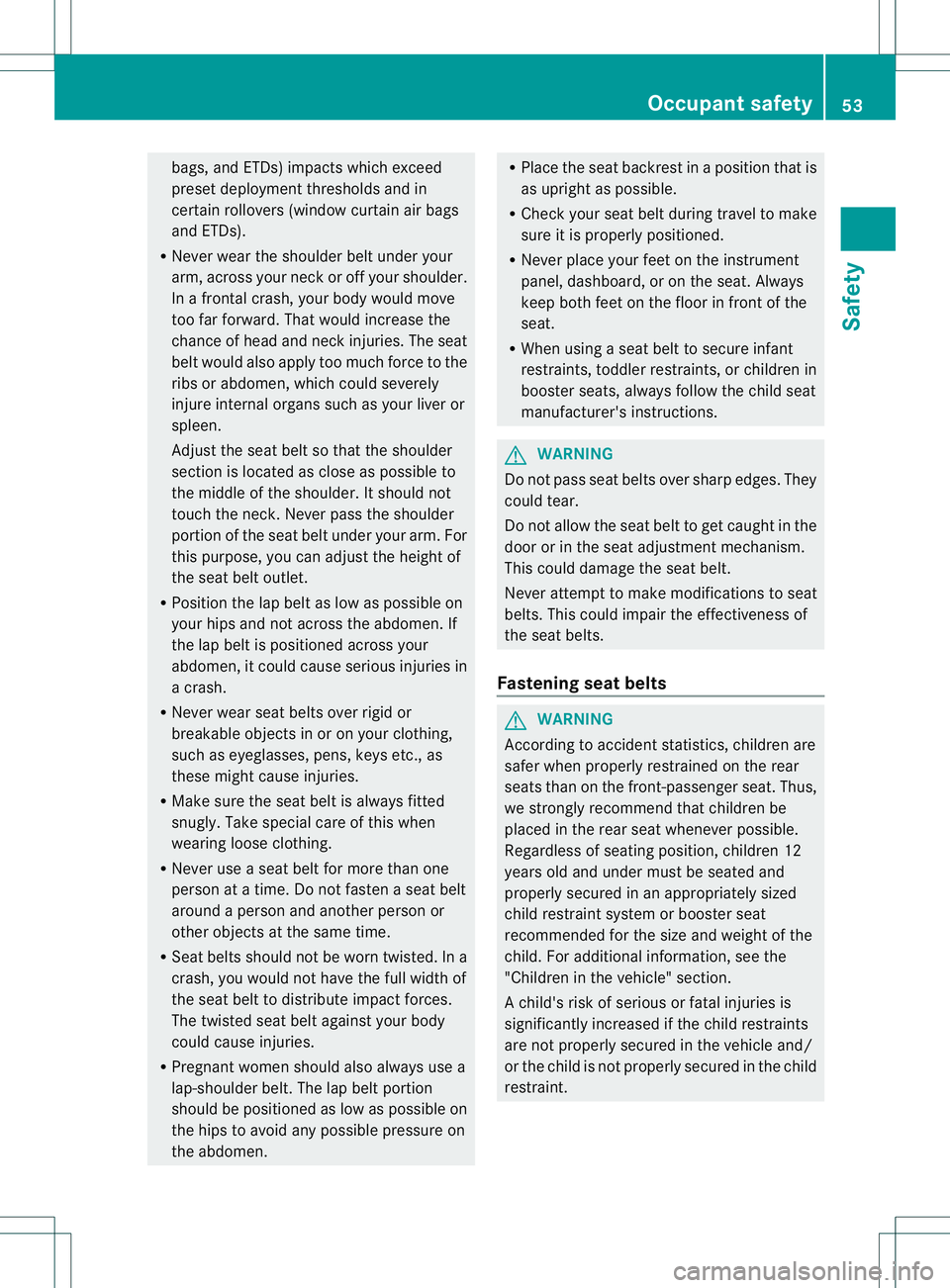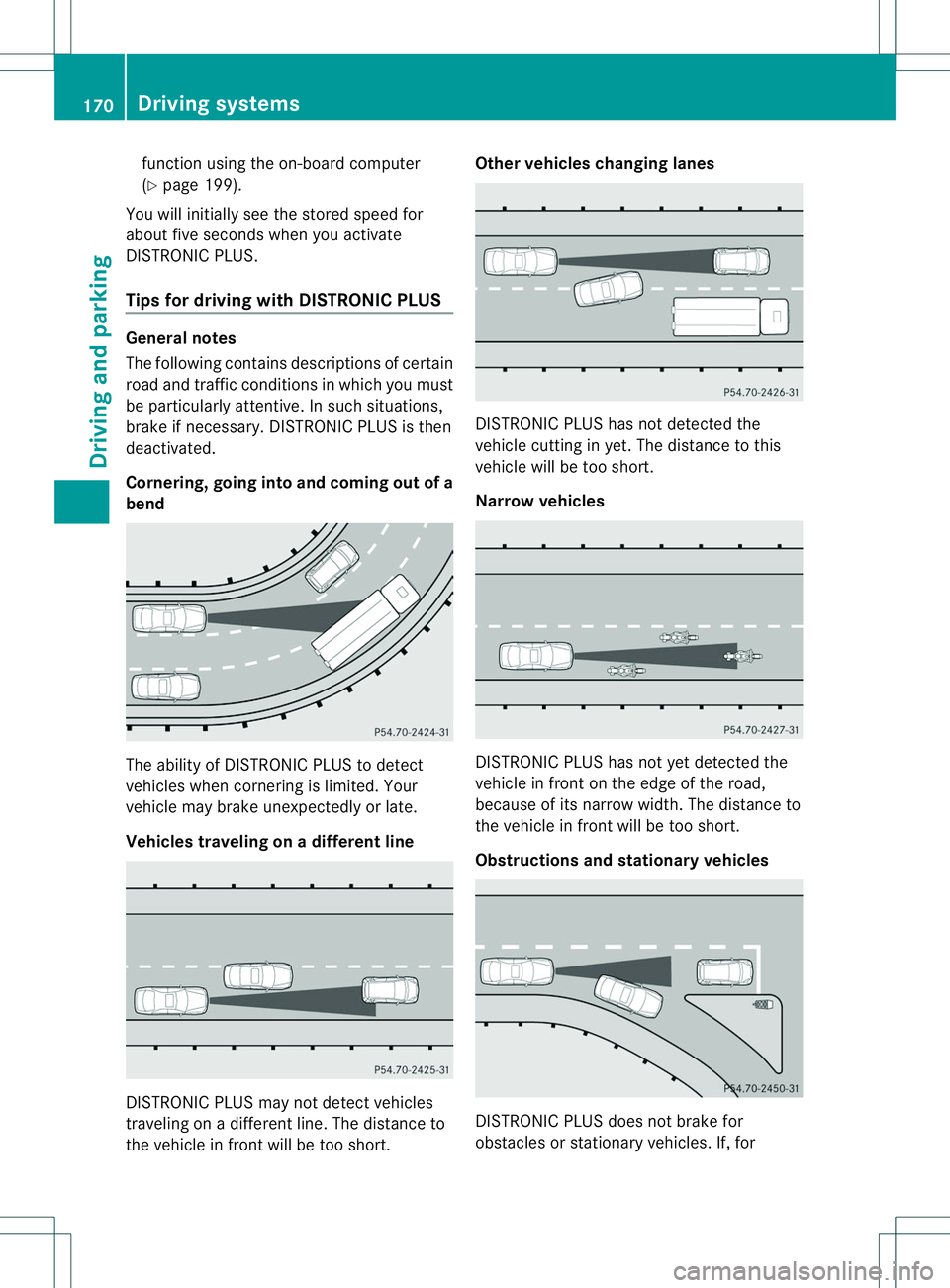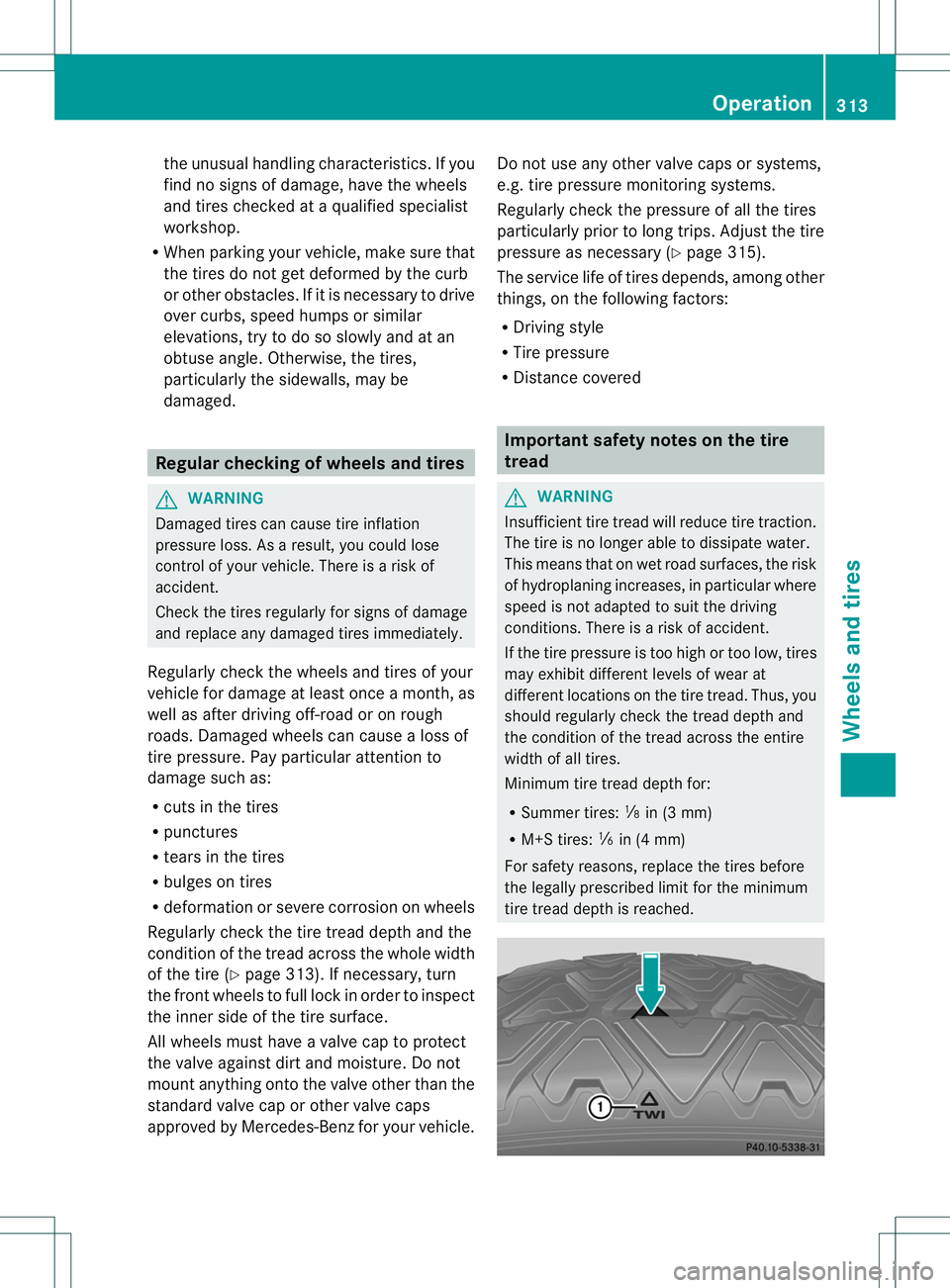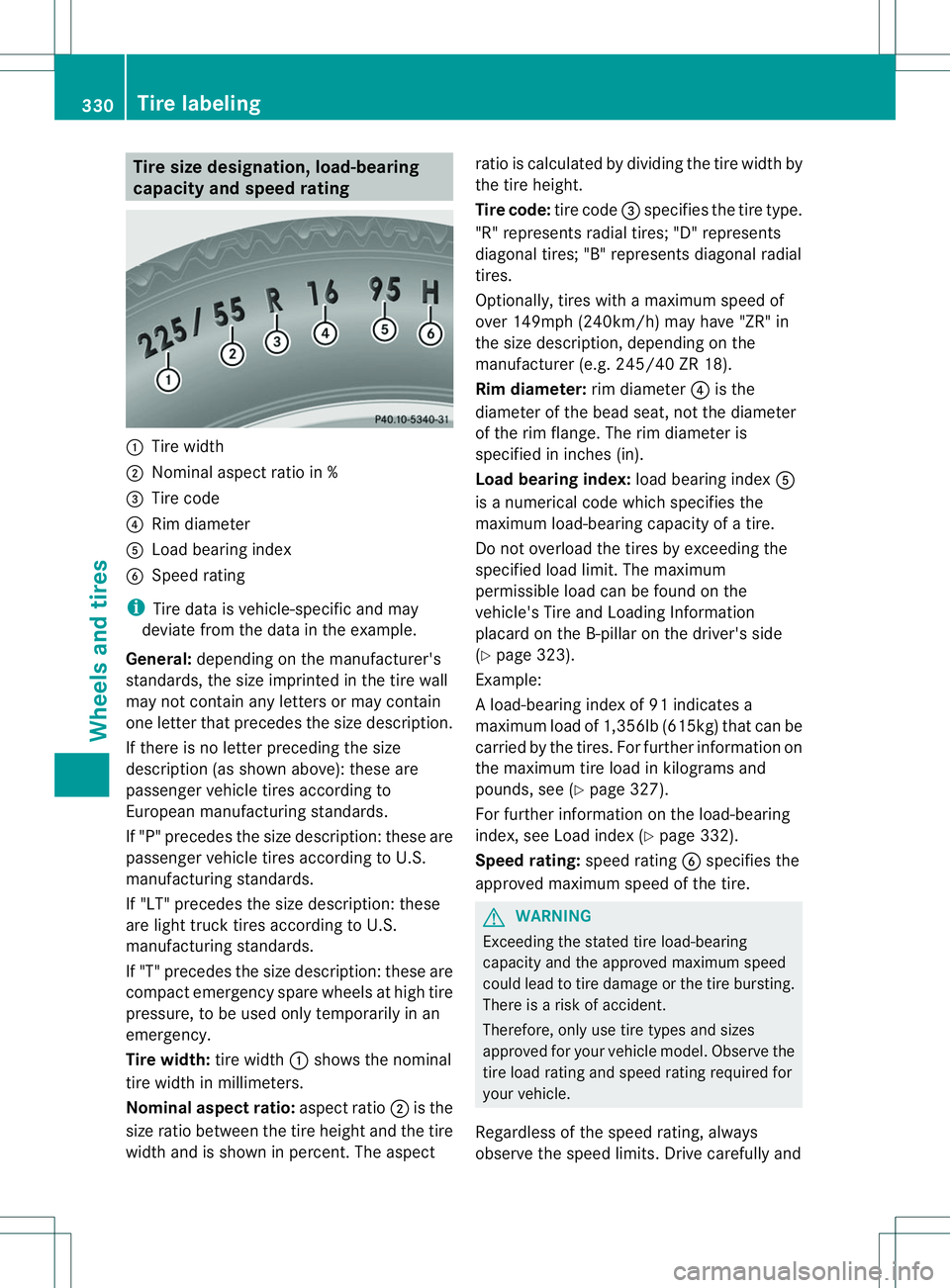2014 MERCEDES-BENZ B-CLASS SPORTS width
[x] Cancel search: widthPage 55 of 360

bags, and ETDs) impact
swhich exceed
preset deployment thresholds and in
certain rollovers (window curtain air bags
and ETDs).
R Never wear the shoulder belt under your
arm, across your nec koroff yourshoulder.
In af rontal crash, your body would move
too far forward. That would increase the
chance of head and neck injuries. The seat
belt would also apply too much force to the
ribs or abdomen, which could severely
injure internal organs such as your liver or
spleen.
Adjust the seat belt so that the shoulder
section is located as close as possible to
the middle of the shoulder. It should not
touch the neck.N ever pass the shoulder
portion of the seat belt under your arm. For
this purpose, you can adjust the height of
the seat belt outlet.
R Position the lap belt as low as possible on
your hips and not across the abdomen. If
the lap belt is positioned across your
abdomen, it could cause serious injuries in
ac rash.
R Never wear seat belts over rigid or
breakable objects in or on your clothing,
such as eyeglasses, pens, keys etc., as
these might cause injuries.
R Make sure the seat belt is alway sfitted
snugly. Take special care of this when
wearing loose clothing.
R Never use aseat belt for more than one
person at atime. Do not fasten aseat belt
around aperson and another person or
other objects at the same time.
R Seat belts should not be worn twisted. In a
crash, you would not have the full width of
the seat belt to distribut eimpact forces.
The twisted seat belt against yourb ody
could cause injuries.
R Pregnant women should also alwaysu se a
lap-shoulder belt. The lap belt portion
should be positioned as low as possible on
the hips to avoid any possible pressure on
the abdomen. R
Place the seat backrest in aposition that is
as upright as possible.
R Check your seat belt during travel to make
sure it is properly positioned.
R Never place your feet on the instrument
panel, dashboard, or on the seat. Always
keep both feet on the floor in front of the
seat.
R When using aseat belt to secure infant
restraints, toddler restraints, or children in
booster seats, alwaysf ollow the child seat
manufacturer' sinstructions. G
WARNING
Do not pass seat belts over sharp edges. They
could tear.
Do not allow the seat belt to get caught in the
door or in the seat adjustment mechanism.
This could damage the seat belt.
Never attempt to make modifications to seat
belts. This could impair the effectiveness of
the seat belts.
Fastening seat belts G
WARNING
According to accident statistics, children are
safer when properly restrained on the rear
seats than on the front-passenger seat. Thus,
we strongly recommen dthat children be
placed in the rear seat whenever possible.
Regardless of seating position, children 12
years old and under must be seated and
properly secured in an appropriately sized
child restraint system or booster seat
recommended for the size and weight of the
child. For additional information, see the
"Children in the vehicle" section.
Ac hild's risk of serious or fatal injuries is
significantly increased if the child restraints
are not properly secured in the vehicle and/
or the child is not properly secured in the child
restraint. Occupant safety
53Safety Z
Page 172 of 360

function using the on-boar
dcomputer
(Y pag e199).
You wil linitially see the stored spee dfor
about five seconds whe nyou activate
DISTRONIC PLUS.
Tips for driving with DISTRONIC PLUS General notes
The following contains description
sofcertain
road and traffic conditions in which you must
be particularly attentive. In such situations,
brake if necessary. DISTRONIC PLUS is then
deactivated.
Cornering, going into and coming out of a
bend The ability of DISTRONIC PLUS to detect
vehicles when cornering is limited. Your
vehicle may brake unexpectedly or late.
Vehicles traveling on adifferent line DISTRONIC PLUS may not detec
tvehicles
traveling on adifferent line. The distance to
the vehicle in fron twill be too short. Other vehicles changing lanes
DISTRONIC PLUS has not detected the
vehicle cuttin
ginyet. The distanc etothis
vehicle will be too short.
Narrow vehicles DISTRONIC PLUS has not yet detected the
vehicle in front on the edge of the road,
because of its narrow width
.The distance to
the vehicle in front will be too short.
Obstructions and stationary vehicles DISTRONIC PLUS does not brake for
obstacles or stationary vehicles. If, for170
Driving systemsDriving and parking
Page 183 of 360

Lanes
001A
White guide line withou tturning the
steering wheel ,vehicl ewidthincluding
th ee xter iorm irror s(static)
0010 Yello wlane markin gtires at current
steering wheel angle, vehicl ewidthtot he
outer side of th ewheel s(dynamic)
0023 Red guide lin efor th evehicl ewidth
includin gthe exterio rmirrors, for current
steering wheel angle (dynamic)
0021 Bumper Guide lines
0021
Bumper
001E Red guide lin eatadistanceof
approximately 10 in (0.25 m) from the
rear of th evehicle
0024 Yellow guide lin eatadistanceof
approximately 13 ft (4.0 m) from the rear
of the vehicle
0007 Vehicle center axle (marker assistance)
0008 Yellow guide line at adistance of
approximately 3ft(1.0 m) from the rear
of the vehicle The lanes and guide line
sare only displayed
if you have engaged reverse gear.
The distance specifications only apply to
objects that are at ground level. Additional display
sonvehicles with PARKTRONIC
and COMAND
001A Front warning display
0010 Additional PARKTRONIC measurement
operational readiness indicator
0023 Rea rwarning display
Vehicles with PARKTRONIC and
COMAND: if PARKTRONIC is operational
(Y page 172), an additional operational
readiness indicator will appear in COMAND
display 0010.Ifthe PARKTRONIC warning
displays are active or light up, warning
displays 001Aand 0023are also active or light up
correspondingly in th eCOMAND display.
"Reverse parking" function X
Mak esure that th erear view camera is
activated and th e"Reverse parking"
function is selected; see th eseparate
operatin ginstruction sfor th eaudio
system/COMAND.
The lane and th eguide lines are shown. Driving systems
181Driving and parking Z
Page 315 of 360

the unusual handling characteristics
.Ifyou
find no signs of damage, have the wheels
and tires checked at aqualified specialist
workshop.
R When parking your vehicle, make sure that
the tires do not get deformed by the curb
or other obstacles. If it is necessary to drive
over curbs, speed humps or similar
elevations, try to do so slowly and at an
obtuse angle. Otherwise, the tires,
particularly the sidewalls, may be
damaged. Regular checking of wheels and tires
G
WARNING
Damaged tires can cause tire inflation
pressure loss. As aresult, you could lose
control of your vehicle. There is arisk of
accident.
Check the tires regularly for signs of damage
and replace any damaged tires immediately.
Regularly check the wheels and tires of your
vehicle for damage at least once amonth, as
well as after driving off-road or on rough
roads. Damaged wheels can cause aloss of
tire pressure. Pay particular attention to
damage such as:
R cuts in the tires
R punctures
R tears in the tires
R bulges on tires
R deformation or severe corrosion on wheels
Regularly check the tire tread depth and the
condition of the tread across the whole width
of the tire (Y page 313). If necessary, turn
the front wheels to full lock in order to inspect
the inner side of the tire surface.
All wheels must have avalve cap to protect
the valve against dirt and moisture. Do not
mount anything ontot he valve other than the
standard valve cap or other valve caps
approved by Mercedes-Benz for your vehicle. Do not use any other valve caps or systems,
e.g. tire pressure monitoring systems.
Regularly check the pressure of all the tires
particularly prior to long trips. Adjust the tire
pressure as necessary (Y
page 315).
The service life of tires depends, among other
things, on the following factors:
R Drivin gstyle
R Tire pressure
R Distance covered Important safety notes on the tire
tread
G
WARNING
Insufficient tire tread will reduce tire traction.
The tire is no longer able to dissipate water.
This means that on wet road surfaces, the risk
of hydroplaning increases, in particular where
speed is not adapted to suit the driving
conditions. There is arisk of accident.
If the tire pressure is too high or too low, tires
may exhibit different levels of wear at
different locations on the tire tread. Thus, you
should regularly check the tread depth and
the condition of the tread across the entire
width of all tires.
Minimum tire tread depth for:
R Summer tires: 0014in (3 mm)
R M+S tires: 0015in (4 mm)
For safety reasons, replace the tires before
the legally prescribed limit for the minimum
tire tread depth is reached. Operation
313Wheels and tires Z
Page 330 of 360

Uniform Tir
eQualit yGrading
Standards Overview of Tir
eQualit yGrading
Standards Uniform Tire Quality Grading Standards are
U.S
.government specifications. Their
purpose is to provide drivers with uniform
reliable information on tire performanc edata.
Tire manufacturer shave to grade tires using
three performanc efactors: tread wear 001A,
tire traction 0010,and heat resistance 0023.
These regulation sdonot apply to Canada.
Nevertheless ,all tires sold in Nort hAmerica
are provided with the correspondin gquality
grading markings on the sidewall of the tire.
All passenger car tires must conform to the
statutory safet yrequirements in addition to
thes egrades.
Where applicable, the tire grading
information can be found on the tire sidewall
between the tread shoulder and maximum
tire width.
i The actual values for tires are vehicle-
specific and may deviate from the values in
the illustration.
For example: Treadwear Traction Temperature
200 AA A Treadwear
The treadwear grade is acomparative rating
based on the wear rate of the tire when tested
under controlled condition sonaspecified
U.S .government course. For example, atire
graded 150 would wear one and one-half
times as well on the government course as a
tire graded 100.
The relative performanc eoftires depends
upon the actual condition softheir use,
however, and may depart significantly from
the norm, due to variation sindrivinghabits,
servic epractices and differences in road
characteristic sand climat econditions. Traction
G
WARNING
The traction grade assigned to this tire is
based on straight-ahead braking traction
tests, and does not include acceleration,
cornering, hydroplaning, or peak traction
characteristics.
The traction grades, from highest to lowest,
are AA, A, B, and C. Those grades represent
the tire's ability to stop on awet surface as
measured under controlled conditions on
specified government test surfaces of asphalt
and concrete. Atire marked Cmay have poor
traction performance.
The safe speed on awet, sno wcovered or icy
road is always lower than on dry road
surfaces.
You should pay special attention to road
conditions when temperatures are around
the freezin gpoint.
Mercedes-Ben zrecommends aminimum
tread dept hof0015in(4 mm )for all four winter
tires (Y page314) to maintai nnormal driving
characteristics in winter. Winter tires can
reduce the braking distance on snow-covered
surfaces in comparison with summer tires.
Stoppin gdistance, however, is still
considerably greater than when the road is 328
Uniform TireQ
uality Grading StandardsWheels and tires
Page 332 of 360

Tire size designation
,load-bearing
capacit yand speed rating 001A
Tire width
0010 Nominal aspec tratio in %
0023 Tire code
0021 Rim diameter
001E Load bearing index
0024 Speed rating
i Tire dat aisvehicle-specific and may
deviate from th edataint heexample.
General: dependingonthemanufacturer's
standards ,the sizeimprinted in th etirew all
may no tcontai nany letters or may contain
on elette rthat precedes the size description.
If there is no letter preceding the size
description (as shown above): these are
passenger vehicle tires according to
European manufacturing standards.
If "P" precedes the size description: these are
passenger vehicle tires according to U.S.
manufacturing standards.
If "LT" precedes the size description: these
are light truck tires according to U.S.
manufacturing standards.
If "T" precedes the size description: these are
compact emergency spare wheels at high tire
pressure, to be used only temporarily in an
emergency.
Tire width: tire width001Ashows the nominal
tire width in millimeters.
Nominal aspect ratio: aspect ratio0010is the
size ratio between the tire height and the tire
width and is shown in percent.T he aspectratio is calculated by dividing the tire width by
the tire height.
Tire code:
tire code0023specifies the tire type.
"R" represents radial tires; "D" represents
diagonal tires; "B" represents diagonal radial
tires.
Optionally, tires with amaximum speed of
over 149mph (240km/h) may have "ZR"in
the size description, depending on the
manufacturer (e.g. 245/40 ZR 18).
Rim diameter: rim diameter0021is the
diameter of the bead seat, not the diameter
of the rim flange. The rim diameter is
specified in inches (in).
Load bearing index: load bearing index001E
is an umerical code which specifies the
maximum load-bearing capacity of atire.
Do not overload the tires by exceeding the
specified load limit. The maximum
permissible load can be found on the
vehicle's Tire and Loading Information
placard on the B-pillar on the driver's side
(Y page 323).
Example:
Al oad-bearing index of 91 indicates a
maximum load of 1,356lb (615kg) that can be
carried by the tires. For further information on
the maximum tire load in kilograms and
pounds, see (Y page 327).
For further information on the load-bearing
index, see Load index (Y page 332).
Speed rating: speed rating0024specifies the
approved maximum speed of the tire. G
WARNING
Exceeding the stated tire load-bearing
capacity and the approved maximum speed
could lead to tire damage or the tire bursting.
There is arisk of accident.
Therefore, only use tire types and sizes
approved for your vehicle model. Observe the
tire load rating and speed rating required for
your vehicle.
Regardless of the speed rating, always
observe the speed limits. Drive carefully and 330
Tirel
abelingWheels and tires
Page 355 of 360

Refrigerant instructio
nlabel Example
:refrigerant instruction label
001A Warning symbol
0010 Refrigerant filling capacity
0023 Applicabl eSAE standards
0021 PAG oi lpartn umber
001E Type of refrigerant
Warning symbols 001Aindicate:
R possible dangers
R having service work carrie doutat a
qualified specialist workshop
Fillin gcapacities Missing value
sweren ot available at time of
going to print. Al
lm odels Capacity
Refrigerant
PA
Go il Vehicle data
Genera
lnotes
Please not ethat for the specified vehicle
data:
R the height sspecified may vary as aresult
of:
- tires
- load
- condition of the suspension
- optional equipment
R optional equipmen treduces the maximum
payload.
Dimensions and weights Model 001A
Maximum
headroom 0010
Opening
height B2
50 73.
8in
(187 4mm) 78.
0in
(198 1mm) B2
50 Vehicle length
171.6 in
(435 9mm) Vehicle width
including exterior
mirrors
79.
1in
(201 0mm) Vehicle height
61.
3in
(155 8mm) Vehicle data
353Technical data Z